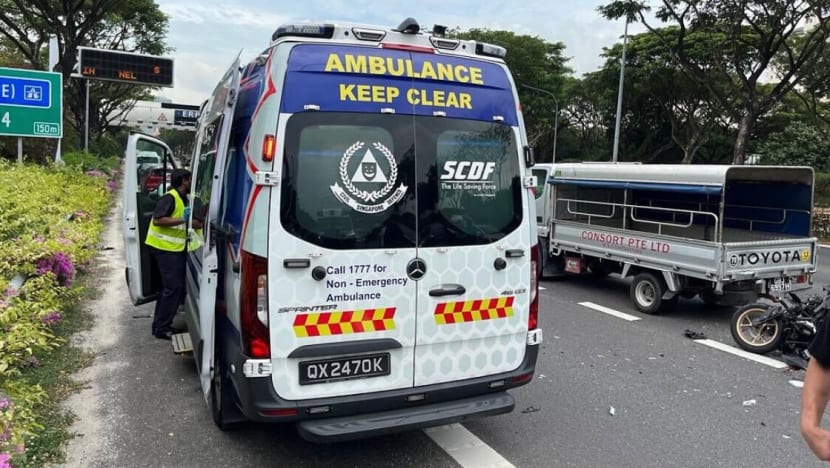Commentary: What holds us back from helping traffic accident victims?
The fear of doing more harm than good remains a barrier in helping accident victims, says CNA’s Alison Jenner.

Ambulance at the scene of an accident along the East Coast Parkway expressway on Nov 8, 2023. (Photo: Instagram/sandrafaustinalee)

This audio is generated by an AI tool.
SINGAPORE: You see a motorcyclist on the side of the expressway, lying motionless in a pool of blood. Would you stop to help? I’d like to think that I would, without hesitation - but I really can’t say it with full certainty.
In a recent accident on the East Coast Parkway (ECP), a 27-year-old motorcyclist died after a crash involving a minibus and a lorry. Reports said it was about 15 to 20 minutes before anyone stepped in to help.
It raised a question many of us may have considered but rarely deeply contemplated: Would you stop to help a car accident victim?
When we encounter a person in distress, our moral compass should ideally guide us to help without a second thought. But in reality, wanting to do the right thing can be overshadowed by fear and uncertainty.
We may wonder if we are truly equipped to provide aid, or if we would end up causing more harm than good. Keeping in mind that this particular accident took place on an expressway with other vehicles going at high speed, there is also the real concern of getting hit.
FEAR OF DOING MORE HARM THAN GOOD
Accidents are on the rise in Singapore. In the first half of this year, there were 3,542 traffic accidents resulting in injuries or fatalities, an increase of 11.8 per cent from the first half of 2022. A total of 4,550 people were either killed or injured in accidents between January and June.
One of the most common barriers to helping at accident scenes is the fear of doing more harm than good. Many of us hesitate because we lack the knowledge and training to provide immediate medical assistance.
While Singapore’s bystander cardiopulmonary resuscitation (CPR) rate has increased from 20 per cent a decade ago to more than 50 per cent today thanks to efforts such as CPR training in schools and the Singapore Civil Defence Force’s (SCDF) myResponder app, it lags places like Sweden and Denmark, where the bystander CPR rate is 82 per cent and 77 per cent respectively.
But here’s the thing: You don’t need to be a healthcare professional to make a difference. Calling emergency services is a critical first step; the phone operators are trained to guide you through the situation until help arrives.
While waiting for the emergency team to arrive, there are also other things that bystanders can do to help, including directing traffic, keeping others safe or putting out a fire, if there is one.
It's better than slowing down just to gawk or taking photos or videos to post on social media.
In the ECP accident, several motorists eventually did stop to help the victim, Muhammad Nurhilmi Atan, but it was too late. He was already unconscious when he was taken to the hospital, and he died the same day.
Indeed, as Mr Ashley Liew, one of several people who stopped to help, said: “A lot of time elapsed from the point of incident ... Those precious 15, 30 minutes could be better utilised."
PRIORITISING SAFETY
Studies have shown that quick emergency medical aid can mean the difference between life and death for accident victims.
In these critical moments, it becomes essential to explore the key factors drivers should consider when deciding to stop and assist a car accident victim on an expressway. What are the potential risks and challenges they might face? How can drivers take precautions to ensure their own safety amid fast-moving traffic?
To get those answers, I turned to experts from Singapore First Aid Training Centre (SFATC), AA Singapore and accident reconstructionist TR Consultants.
The overriding advice was that drivers should carefully evaluate the situation and prioritise their own safety before stopping.
“Drivers can face serious danger especially on a highway compared to normal roads,” Mr Thanaraj Ramakrishnan, an accident reconstruction specialist at TR Consultants, told CNA. “Dashing across these lanes to assist could pose a potential risk of danger to their own safety. By doing so, this may force oncoming traffic to drastically slow down and/or make evasive manoeuvres, increasing the risk of another accident or chain collision.”
Still, with some knowledge, understanding and preparation, might it be possible for drivers to respond reasonably safely and with competence on highways or otherwise?
Drivers who decide to assist should reduce their speed and find a safe place to stop, one that does not obstruct traffic, the experts said. They should park about 30m to 50m past the crash site on the same side of the road, and place a warning sign about 10m to 15m from the scene to alert other drivers.
“Do not take for granted that passing drivers will conduct themselves safely around the crash site. Inattentive drivers will not notice the crash site and may fail to stop, resulting in another accident causing serious injury to those who are there to provide aid,” said Mr Edwin Leong, training director at SFATC.
Drivers can get other people around to help to stop or slow down the traffic by hand gestures. Individuals can do so by indicating their hazard lights or by setting up their vehicle's warning triangle.
“It is important to note that injured parties should not be moved unless absolutely necessary as internal injuries are not always apparent and movement may cause further injury,” said Mr Thanaraj.
COMPASSION OVER INDIFFERENCE
The ECP accident brings back memories of the 2019 fatal accident at Lucky Plaza, where two Filipino domestic workers were killed and four others were injured after a car ploughed into them before crashing through a metal railing.
Videos circulating then showed several bystanders working together to lift the car and pull a woman out from under it.
In moments of crisis, those who stepped in chose compassion over indifference.
It's time for us to be the change we want to see. If you're unsure about what to do, let the victims know that help is on the way. Sometimes, just offering support can make a world of difference to someone in distress.
Alison Jenner is Supervising Editor at CNA Digital where she oversees commentaries.



















